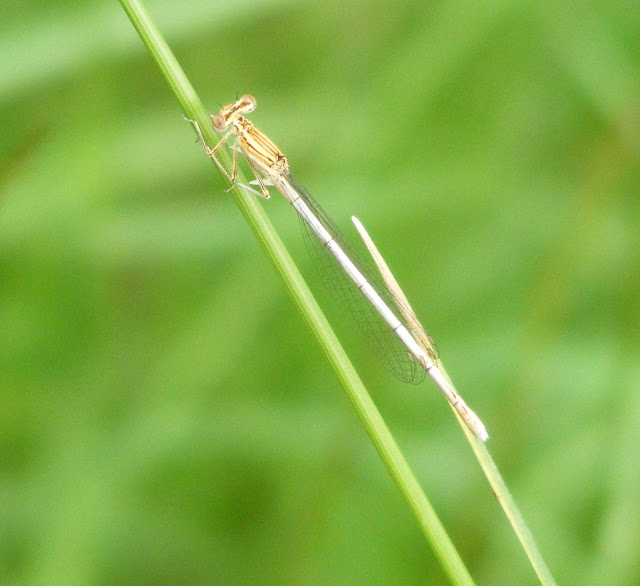 |
Western Spectre dragonfly Boyeria irene (Fr. L'Aeschne paisible), resting in a typical position, under the eaves of a building.
|
Saturday 26 June saw me heading off to Chambourg sur Indre to meet Franck the Forester and Fern Guy. We were going on an outing to a privately owned parcel of woodland to look at ferns and mosses, joined by Marie-Claude and her husband Patrick, Corinne and Christiane. It was a lovely setting, owned by a young brother and sister who inherited it. There is a small lake and a well built shed with a fireplace and outdoor furniture. It's a proper little retreat.
 |
Common Figwort Scrophularia nodosa (Fr. Scrophulaire noueuse).
|
Franck explained that there weren't actually many species of ferns on the site, but ferns hybridise extremely easily, so they are challenging and you need to check every plant to determine their lineage. As a bonus there were some nice butterflies and dragonflies around the lake. There was also a large scat full of big beetle wing cases -- maybe a badger or a fat hedgehog has been feasting on Stag Beetles and Ground Beetles, amongst others. Or maybe it's an owl pellet, which seems more likely given the sheer quantity of beetle bits.
 |
Large Tortoiseshell butterfly Nymphalis polychloros (Fr. La Grande Tortue).
|
Franck's day job is as a consultant to owners of small private forestry parcels like this. He is concerned about how unbalanced the forest ecology is becoming. Wild Boar numbers are increasing, which means their excrement is causing the soil nitrogen levels to rise. This in turn is leading to an increase in pathogenic fungi which are attacking trees of all sorts. Added to that is the practice of replanting broadleaf forest with pine. Owners are obliged to reforest areas which are felled for timber, but most choose the quick and easy solution of planting pine, rather than the long slow process of allowing the forest to regenerate naturally. Franck would like to see early succession trees like birch and downy oak, with no commercial value, left as long as possible, so that the regeneration is as natural and therefore as resilient as possible to the increasing frequency and intensity of periods of drought. He says many pine trees in the Loire Valley forests died in the drought last year, especially around Orléans.
 |
What I think is probably an owl pellet, full of beetle wing cases.
|
There are 150 000 hectares of forest in Indre et Loire, close to a quarter of the total area of the département, of which the vast majority, 130 000 hectares, is privately owned and managed. There are many small non or semi-commercial parcels, but 70 000 hectares are parcels over 25 hectares, managed primarily for timber production. The site we were visiting was 50 hectares.
 |
The étang (small man-made lake) on the property.
|
We have been talking to a local joiner about getting new windows. We had a quote from him which seemed reasonable, but now he has let us know that he will have to recalculate because there is such a shortage of wood in France and he is obliged to put prices up a lot. He said that at the beginning of the pandemic, the US and China basically sucked up the global supply of wood with huge orders for imports. Later I heard on the radio that the problem was that in China it has not been permitted to extract timber from homegrown forests for some decades, so they have to import. They are prepared to pay 15% more than the domestic rate for French oak, and so it is going to China. Tant pis for us and our hope of getting new windows any time soon.
 |
Blue Featherleg damselfly Platycnemis pennipes (Fr. L'Agrion à large pattes).
|
On a more positive note, I wore my new waterproof hiking boots, bought for €35 in Noz, a Romanian brand called S-Karp, and they were a tremendous success. Super comfy and not too heavy.
 |
Horned Tree-hopper Centrotus cornutus (Fr. Demi-diable) on bracken.
|
 |
Looking at a fern in the forest.
|
 |
There was a nice colony of the buckler fern Dryopteris x complexa in one part of the forest. This is one of the dreaded hybrids, but common enough to have its own name. The parents are False Male Fern D. affinis and Male Fern D. filix-mas.
|
 |
A 'cigar' made by a Hazel Leaf Roller Apoderus coryli.
|
 |
Marmalade Hover Fly Episyrphus balteatus on a bramble flower (which has changed colour from white to pink because it has been pollinated).
|












2 comments:
I love male ferns. I brought one from the wild many decades ago. It has survived and proliferated in my small yard in Paris.to my joy!
We live in a world of ferns and we both love them and grow them in our garden. Love the Horned Tree-hopper - what a beast!!
Post a Comment